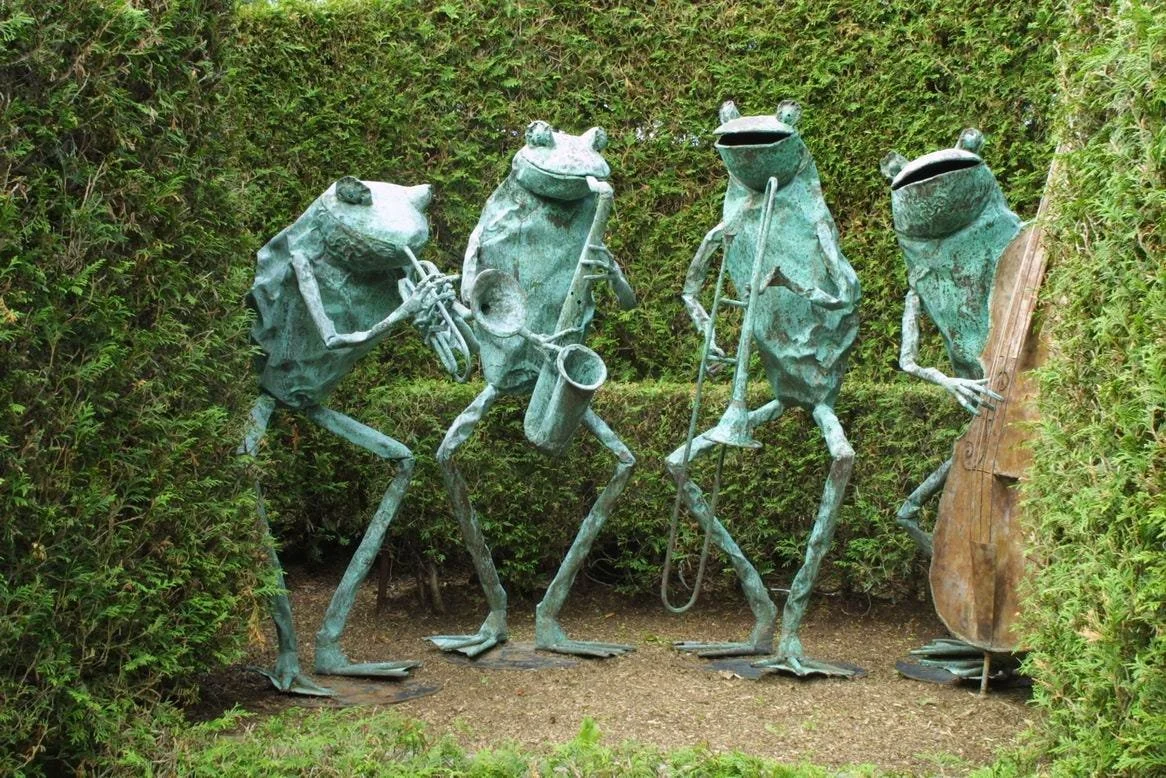What is strategy?
Strategy is Future Competitive Advantage.
What will the future look like? What will people need and expect? How will demographics, technology and other global shifts create new competitors or recharge current competitors and how will categories blur, blend and maybe even disappear?
Amidst these new expectations and changing competitive dynamics what advantage will your company offer? A differentiated or better product? A competitive moat of network effects, scale or some other dynamic? A better experience? Speed and value?
While Strategy firms can be amazingly helpful in guiding companies through these questions, most leaders already have a gut instinct on what needs to be done. The deep dive documents, the chanting strategists and the long march of meetings are to bring others along and to provide an intellectual and analytical framework for a decision that clearly had to be made.
If you work for a firm and you have an idea of where the future is going and how changing people’s expectations and emerging technology are going to create challenges or opportunities, you should go to your management and share your thinking.
All you need to talk about is future competitive advantage.
Why strategies often fail in implementation.
Companies often allocate large swaths of senior management time and budgets for outside specialists to help them sculpt and then move the strategy forward.
A cavalcade of consultants convey and communicate with countless charts and creative conjuring to the C-Suite.
A flurry of futurists frame, focus, and filter the way forward with the finesse of fortune tellers.
Masters of the Universe market M&A moves that might make multiples move upwards and mean many more millions in market-cap.
PR professionals produce and promote points of view that provoke the press to perceive with pristine perspectives.
These efforts when successful result in the first three key steps to strategy implementation
1) A simple and differentiated strategic blueprint.
2) An M&A plan to acquire skills, markets and technology.
3) A re-organization since the future does not fit in the containers of the past.
These are essential ingredients to a recipe of change and growth none of these will work without helping grow and change the people in the organization.
Because while firms are a collection of ideas, technologies, patents, brands, ecosystems and people, it is people who are the key since they create the ideas, technologies, patents, brands and eco-systems!
Michael Tyson said, “Everyone has a plan till they get punched in the face”.
Boards and leadership of firms come quickly to the realization that everything is easy until people get in the way.
Telling people that change is good, threatening them with job loss if they do not change or creating communication materials and slogans to goad them into a cult like devotion to the new dear leader or the way forward rarely works in the short run and will likely fail after the threat of flagellation fades.
Because if there is nothing in it for them, people will out-wit, out-wait, out-pretend, and out-maneuver “management”. Until then they will fill the time genuflecting and bowing and going through the monitored motions of attending the right meetings, muttering the motivational mantras and stating the slogans required.
The keys to implementing strategy.
If a strategy is to be leveraged in ways that transform an organization, it is key to remember that the only true transformation happens is when the mindsets, skillsets and behaviors of the people working for the firm transform.
If you want your organization or team to grow and change you will need to ask your team to initiate a) a three-question exercise while leadership b) delivers three clear answers to employees.
The Three Question Exercise every team should consider doing so they can both understand, get aligned with and contribute to strategy.
1) How do we expect peoples as well as our customers/consumers/members needs and expectations to change in the future?
2) What are our key strengths and weaknesses in meeting and aligning with these shifts?
3) I3) If we had no constraints except that we had to ensure that what we did was legal, that it was technologically possible and financially broke even in 3 years or less what products and services would we design? Alternatively if we gamed ourselves as a new entrant in attack mode how would we take market share away from ourselves on a particular product or customer segment?
This exercise makes people look up from their day to day and understand risks and opportunities and helps them realize the need for doing things differently. As importantly it gets them to contribute and activate the strategy in their areas of competence and expertise. It also allows leaders to go into attack mode versus thinking only defensively.
The Three Clear Answers management needs to deliver to company staff in order for them to align with and implement the strategy:
1) Why are the recommended changes good for their personal career growth?
2) What are the monetary or other incentives to change?
3) When and where will training be provided to help them learn the new skills needed?
Change does not happen because of M&A, press releases, re-organizations or a new leader, all of which undoubtedly play a role.
An organization changes and grows when the people in the organization change and grow.
Images created using Mid-Journey
Chances. Changes. Choices.
In many ways a life or a career is the aggregation and summation of choices made, chances given and taken, and changes navigated.
Chances.
Chance drives much of life, beginning at birth.
Who we are born to, and the country we are born in, drives so many of the contours of our life and what we can become.
Being born to loving parents who are financially secure in a developed or rapidly developing country is a stroke of great luck which we often do not appreciate since the opportunities are greater and obstacles far fewer than someone born to struggling parents in an impoverished or war-torn nation.
Chances then adorn all of life in the chance meeting, the people who take chances on us and the chances given.
But as importantly the chances taken whether it be moving to a new place, betting on a new job, and taking risks.
And if we are fortunate life also is about chances we give.
The helping hand, the forgiveness provided, the small investment, the life changing advice and the risky hire.
Changes.
Change is life.
Everything changes and nothing stays the same.
Economies bloom and burst. New leaders come and go. Health fluctuates. Relationships thrive and wither. Technology enables and disrupts. Great misfortune and loss are interwoven with unexpected windfalls and victories.
Navigating change is often both facing its reality and learning that how we adapt and respond to change and changing times determines its impact on our lives and the future more than the change itself.
In Hamlet, Shakespeare wrote, “there is nothing good or bad but thinking makes is so”
Choices.
“The difficulty in life is the choice” George Moore.
The choices we make are often determined by chance and change but unlike chance and change tend to be more under our control.
Because chance and change constantly offer us the option or sometime force us to make choices.
And choosing is not easy particularly since the future is unknowable and only as time unfurls will it be clear which choice among many was the ideal.
While every choice impacts us the three biggest choices tend to be a) what we do for a living, b) who we decide to spend our lives with and c) where we decide to live.
Career. Home. Partner.
These are not necessarily one-time choices which since we can change careers, where we live and who are partners are, but these seem to be the most important ones and its probably the ones we should spend the most times mulling.
And we humans even if we make the right choices we wonder if we did.
The job not taken, the person not pursued, the place not moved to. We often think life might have been even better if we had made other choices often forgetting it might have been much worse.
A good exercise in self-reflection is to think about the biggest changes, chances and choices we have had to deal with or had to make and what we have learned from those.
Since as long as we live, we will have to deal with chances, changes and choices.
Exit.
Exits are as important as entrances.
We are told first impressions are important.
They are, but so are are endings.
Here is a perspective on three types of exits.
Exiting Careers. Exit Economics. Exiting Existence.
1. Exiting Careers.
“Every career has a midnight hour. The smart people exit at five to twelve” Sanjay Khosla ( Executive Coach and Advisor. Former President of Kraft Developing Markets.)
Elegant exits particularly at senior levels are unfortunately too rare, leaving both the Individual and the Company diminished.
The individual loses since a career transition not handled well can stain a reputation and leave a residue of ill will towards an institution where many years of one’s life has been dedicated.
The company loses because instead of having advocates among an influential diaspora of senior talent one may end up with hecklers and detractors. Also, senior colleagues and direct reports of the departed employee can feel less loyal to the company.
It behooves both the individual and the firm to anticipate, plan and manage for the midnight hour whenever possible.
Done correctly it can provide significant advantages to both sides. The company can often retain access to the wisdom and knowledge and good will of the departing employee and the individual benefits from a positive departure, continued access to their friends and network and often Career 2.0 opportunities and support.
Every company should develop a plan to ensure that Exits are done right particularly given both aging demographics and the increasing flexibility that companies need to to connect and leverage a diaspora of talent without carrying heavy fixed costs.
2. Exit Economics.
Every year you should call your cable company and telecommunications provider and ask if they can give you a better deal. You do not need to threaten to leave but just ask politely. Chances are you will get a combination of higher speeds, removal of data caps, free channels, upgraded modems and cable boxes and other goodies usually at the same or lower cost.
You rarely have to use the three magic phrases:
a) “Considering cutting the cord”
b) “Read about a T-Mobile offer…”
c) “Why am I paying so much to rent this old equipment?”
Then call your financial institutions and you will enjoy eradication of some fees, lower rates of interest, higher multiples on loyalty rewards and other garnishments.
And for anybody you do business with if you need to find yourself not needing to find the right support or service person (automated and hidden contact numbers anyone?) just press the option that says you want to exit. And presto you have a Manager on the line!
Why do so many companies that wax poetic about customer lifetime value and the importance of retention rarely reach out to reward their most loyal customers?
Why do so many service businesses not surprise and reward their best clients with ideas, insights and imagination every six months but only do this when clients threaten an exit or in attracting new clients?
As more and more companies are trying to move from a transaction to membership model focusing on recurring revenue it will grow more important to focus on the happy bird in the hand than the one in the bush or the one wishing to fly away.
We should take a little time off from cross-selling, up-selling and treating each customer as a cow whose udder we squeeze to maximize a bottom line while whispering rote love and loyalty messages into their ears.
How about feeding them some hay instead once in a while?
Every six months (in some cases more often and in some cases less often but at least once a year) surprise your best customers with gifts, offers, insights and rewards without them asking.
This is the economics that prevent their exit rather than spending millions getting them to change their minds once they have determined to exit!
3. Exiting Existence.
Franz Kafka wrote “The meaning of life is that it stops”
And most of us can calculate the robust and healthy days left if we are lucky by subtracting our age from 80 (around which much begins to go wrong physically and sometimes also one may see a diminishment in mental faculties leading to a much more constrained life) and multiplying it by 365 days.
If you are 60 you have less than 7500 days. If you are 40 you have 15,000 days.
So, when someone asks you to do things without some form of fair compensation (it does not have to be money but could be learning, experience or the joy of helping) or does not respect your time, do remember you are the one paying for their dis-respect and their cheap valuation of your life!
Once you incorporate the reality of your and everybody else’s finiteness into your thinking, you are much less likely to take crap from those who dole it out and much more likely to appreciate those who are kind and respectful.
And notice the wonder of everyday life around you.
As the Philosophers and Songwriters remind us:
It is essential to know what is important before it is too late.
The Garden Inside.
Art by Uta Barth
The World Is Too Much With Us.
The opening lines of “The World is Too Much With Us” by William Wordsworth:
The world is too much with us; late and soon,
Getting and spending, we lay waste our powers;—
Little we see in Nature that is ours;
We have given our hearts away, a sordid boon!
Today we are buffeted by a tsunami of external drama which keeps us unmoored.
This in addition to an algorithmically optimized drip drip drug flow of attention hungry engagement orifices seek to bend us to look here, look there, feel this and feel that.
The outside world is often too much with us.
But it is in internal changes where the meaning lies.
Looking is not the same as seeing.
A few years ago an exhibit at The Modern Wing of the Art Institute of Chicago featured the work of a Los Angles artist named Uta Barth.
Ms Barth leverages photography in a novel way to get you to both see what you may not have seen but as importantly to make you forget what you are looking at but be aware of the resultant feeling.
Her work which can be simple as conveying the feeling of light on a curtain or a shadow on a kitchen wall is inspired by a line from Robert Irwin which goes…“Seeing is forgetting the name of the thing one sees”.
We often look but do we see?
The Garden Inside
Have always enjoyed parks and gardens and am lucky to live by the lakefront in Chicago which is adorned with parks. These are great spaces to reflect, refresh and repair, particularly in these drama filled times.
One of the parks in Chicago—Lurie Garden in Millenium Park— has been designed by Pier Oudolf who is considered among the greatest Landscape Designers in the World (he also landscape designed the High Line in New York). His books are filled with breathtaking foliage that integrate and blend into nature likes works of art.
But there is one garden that may stand above them all
In the Charlevoix region of Quebec there lies a private garden which covers more than 20 acres and is called Les Quatre Vents ( The Four Winds). It is considered amongst the finest private gardens in the world ( it is opened a few times a year to the public).
The garden was created by one person, Francis Cabot, as his life work that blends creativity and passion and it is simply the most breathtaking places one can imagine.
Francis Cabot believed that Gardens are like art and have the power to change you. And unlike other art, which may affect you differently over time, because you have changed over time, a garden is itself always changing. Francis designed his Garden to lift the soul of people who walked through it.
He wanted you to come out different after the experience.
Cabot has sculpted, designed and tended a variety of different types of structures and styles —a total of 24 different experiences—including a Japanese garden, a French Pigeonnier – pigeonnier is French for both pigeon coop and pigeonhole – and integrated water ways and a variety of bridges all using natural materials from place of origin. The Japanese tea house was built by Japanese artists using wood from Japan that was aged for years.
Here is a peek at Les Quatre Vents…
There is an amazing book called “The Greater Perfection” filled with pictures and Francis Cabot explaining his life’s work, which I would recommend to everyone if it were affordable and easily available.
Doctors would prescribe it would for the soul.
However, there is a wonderful movie on Francis Cabot called “The Gardener” which is available for free on Amazon if you are a prime member. Take a look at this two minute trailer and it alone should lift you and calm you down.
One prescription for the pressures and challenges we face is to take a walk in a garden.
Regardless, it is key to remind ourselves of Francis Cabot’s belief that every individual is creative and we have a garden within ourselves that we need to tend to so that we can bloom…
4 Keys to Leading Today.
Companies with a disproportionate share of talent passionately aligned against a common goal usually are the ones that grows faster, create great economic value and attract and retain customers and clients for the long run.
This alchemy of wealth, value and alignment is often created by the wizardry of leaders.
Leadership has never been as important today in a world in midst of great transformation.
In the end great leadership come down these four components:
Leaders acknowledge, face and communicate reality.
People admire and respect people and not titles since titles are bestowed while leadership is earned.
The five characteristics of great leaders are capability, integrity, empathy, vulnerability and inspiration.
Great leaders scale their talents by creating a fabric of great culture.
1. Reality.
A key to leadership is to solve challenges and address problems. This requires confronting issues versus looking away or hoping some form of magical thinking will make them go away.
One cannot hope to get people to follow us if they suspect we are not addressing real issues and challenges however difficult they may be.
Great leaders ensure they never set themselves for self-defeat.
They do this by constantly taking temperature of the marketplace, anticipating opposing points of view and paying close attention to underdogs and outliers who might change the rules of the game.
They focus on future competitive advantage and not yesterday’s game.
2. Respectful Admiration.
Without the hearts and minds of one’s team one is not a leader but a ruler.
Rulers leverage fear, project power and exploit insecurity.
Employees genuflect, fall in line, salute and pander to the hollow and bloated boss, while they silently seethe, plot insurrection or practice defection.
All rulers fall and increasingly they are failing and falling faster as they flail and rail with great cacophony.
But facts are stubborn things.
Reality has a habit of breaking in.
Gravity does not care if you tweet that it is fake.
It kills those who step off cliffs and tall buildings.
Leaders on the other hand are respected and admired both for their operating and strategic skills but they earn the most important currency of the time that allows them to buy time and alignment in changing times.
The currency of trust.
3. Five Characteristic of Leaders.
a) Capability: To be a leader you have to be capable in your field of work or craft. You have to know your shit. You have to keep improving your skill. Doctors will not listen doctors who are not great at medicine. A creative will not respect someone whose body of work they do not admire.
b) Integrity: Can one be trusted? Are we transparent about the ingredients of our decision making. Does one look for opposing evidence and use real facts ?
c) Empathy: Leaders can see from other points of view and they understand that employees are people and work is but a sliver of their being. They understand and they listen. They care. They do this both for employees and for customers.
d) Vulnerability: Great leaders acknowledge mistakes. They know they do not have all the answers. This means they are open to criticism and correction and they surround themselves with skill sets that offset and balance their areas of weakness.
e) Inspiration: How do leaders face and acknowledge reality and hard truth but still get people to unite, align and take the challenges head on? They do so by recognizing that people choose with their hearts and not their minds. They inspire through a combination of personal example and storytelling.
4. Culture.
It has been said that “culture eats strategy” and often when companies decay (Boeing) or resurrect ( Microsoft) or have distinctly different outcomes in the same industry ( Delta vs most other airlines) a key determinant is the culture. What it is like, how it is improving or how it is getting worse.
The culture of an organization is revealed in how people behave when no one is looking or monitoring their behavior.
Culture is about the relationships, mindsets and goals of people and not a place, a program or an operating manual. It is something leaders set, correct and support, but culture is how leaders treat people and how people feel about themselves, their company and their colleagues.
Companies with great cultures tend to have employees who feel most of the following about their jobs and companies:
Fair/ Good Compensation: If people are not paid adequately or fairly it really hard to have a good culture.
Recognition: Great cultures recognize contributors and leaders do not step into their teams video stealing credit.
Autonomy: People are trusted to deliver with limited monitoring and can access resources to do so.
Purpose: They believe in the purpose and values of the company and see the role of their company beyond that of just profit but doing good for society or community.
Growth: The company is growing, has a plan for growth or even if static, the individual is growing and teams are growing by being given opportunities to learn and build new skills. The focus is on multiplying versus dividing.
Connectedness: People feel connected to each other and to their leadership. They feel free to speak up and share and even joke.
While some leaders today may disappoint there are many many amazing leaders across all aspects of business, education and government who we can all learn from by paying as much attention to those who lift us up versus those who bring us down.

















